



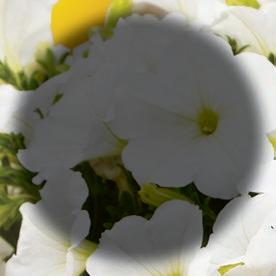










2022 | ISSUE 103 Your local gardening advice for Australian gardens www.aboutthegarden.com.auFOLLOW US ON
The Serenity Prayer
God grant me the serenity to accept the things I cannot change; courage to change the things I can; and wisdom to know the difference.
Living one day at a time; Enjoying one moment at a time; Accepting hardships as the pathway to peace; Taking, as He did, this sinful world as it is, not as I would have it; Trusting that He will make all things right if I surrender to His Will; That I may be reasonably happy in this life and supremely happy with Him Forever in the next. Amen. Trust in the LORD with all your heart and lean not on your own understanding; in all your ways acknowledge him, and he will direct your paths. Proverbs 3, 5-6
Floral

Front cover image: New Wave Petunias, White - Ball Australia

Managing Director: Conway Searle

Contributors: Ashley Searle, Jillian Coomb, Diggers.
Magazine Manager: Alana Searle
Design & Layout: Alana Searle
ATG Group Co-ordinator




& Advertising: Jason Searle
About the Garden is published seasonally by About the Garden Pty. Ltd. ABN 21 076 919 992 • 4914 D’Aguilar Highway, Kilcoy or P.O. Box 70, Kilcoy Qld. 4515 Ph: (07) 5422 3090 atg@aboutthegarden.com.au
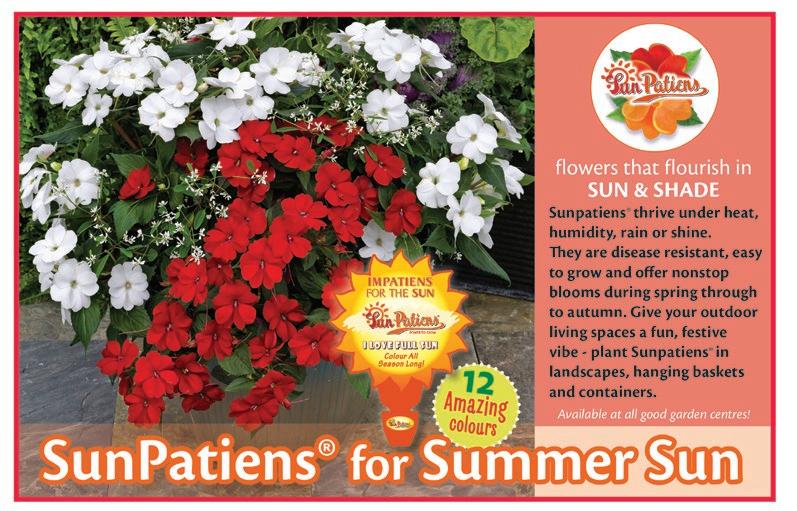

The material appearing in About the Garden is subject to copyright. Other than as permitted by the Copyright Act, no part of this magazine may be reproduced without the permission of the publishers. No responsibility is accepted by About the Garden Pty. Ltd. for the accuracy of information contained in the text, illustrations or advertisements. Although believed to be accurately and correctly sourced, thereof disclaims any liability against itself, editor/s or employees arising from any person acting on the material herein. The opinions expressed in the magazine, or by contributors, do not necessarily represent the views of the publisher. ©Copyright 2022 About the Garden Pty. Ltd.
About the Garden Magazine is proudly produced from sustainable resources.
Let nothing disturb thee. Let nothing affright thee All things pass God never changes. Patience gains all.
Who has God. Wants for nothing. God alone suffices. (St Teresa of Jesus)
Con Searle
New releases p4
emblems of Australia p8 Issue 103 TM Summer 2022 At your local - In season plants - Flowers 4 - Natives 7 Floral emblems of Australia 8 Natives for pots & baskets 10 Cucumbers 14 Chillies 15 On the table - recipes Garlic prawn pasta 16 Levantine Tabbouleh 16 Pineapple crush drinks 17 About summer - Edibles 18 - Flowers 19 - hoyas - Keeping Christmas trees 20 - Climatic zones 20
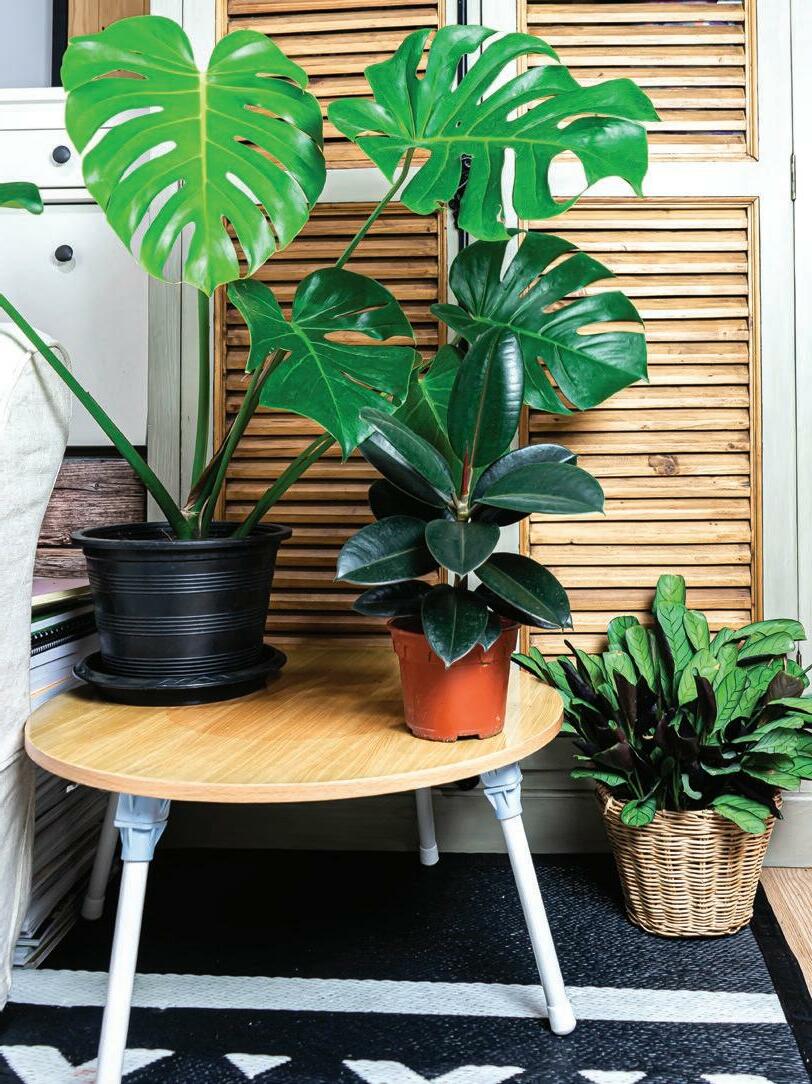





searlesgardening.com.au like us!
Magical Rubyred’






Imagesandinfoon thispage, courtesy ofwww.pma.com.au













‘Magical Pearl’ is a stunning clear white flower held on strong stems over deep green foliage. After a few weeks from the peak of flowering, the white ages to a chartreuse green that looks great in bouquets or as dried flowers. Flowers are formed on both old and new wood, so pruning shouldn’t be done unless necessary. With that said, the white flowers can be pruned at any time to make way for fresh new flower stems.

‘Magical Rubyred’ has the deepest burgundy flowers of any Hydrangea. The rousing red display starts in spring and goes through to autumn finishing with an exotic dusky mulberry. Bring a splash of passion and romance to your garden or as an indoor tabletop feature. Perfect for the festive season.

The hydrangea ‘Magical’ series are perfect container displays for patios and long lasting garden bed colour and equally used for indoor colour. Ideal for home-grown cut flowers for gifts and home decoration.
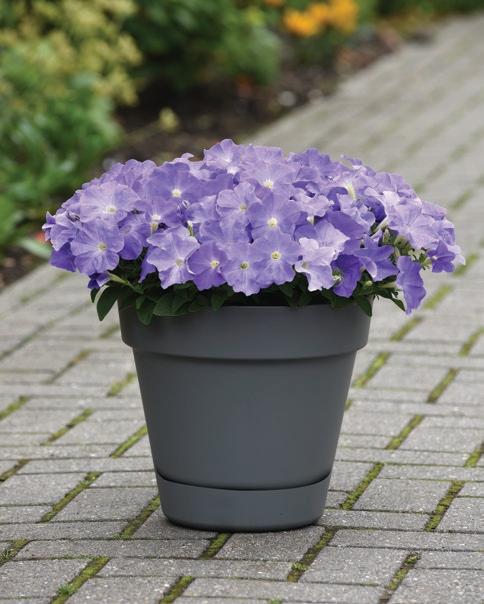
Hydrangeas in the ‘Magical’ series are best grown in part-sun and afternoon shade in moist well-drained soil.
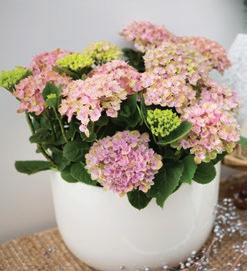
Plant in Azalea, Camellia & Gardenia Specialty Mix for 9 months feeding.







A revolution for gardeners and home decorators, bringing garden beauty into the home. Flowering continuously for up to 150 days with a magical colour transformation from pastel pink or blue, through to deep burgundy, this is a compact plant that really performs – indoors and in the garden. A living bunch of flowers, perfect on the kitchen bench and will outlast any cut flowers by months and months.

Equally happy outside, Hydrangea ‘Magical Revolution’ has improved resistance to sun, frost, rain and all the elements. Plant in an acid-loving planting mix - Searles Azalea, Camellia & Gardenia Specialty Mix for pots and gardens.

see what’s new at your local gardening outlet
page 04 | About the garden magazine SIZE 90cmH 90cmW LOVES POTS
CUT FLOWERS
INDOOR FRIENDLY FRIENDL
SIZE 70cmH 70cmW
‘Magical Pearl’
SIZE 120cmH 120cmW
CUT FLOWERS
Petunia x hybrida


If you want to fill a flower bed or large planter with an eye-catching pop of colour, wave petunias are the plants to get!




With seven colours in the range, the New Wave® range provides a mound of big, vibrant coloured blooms up to 7cm across all season long, ideal to fill your containers, baskets, window boxes and landscapes fast and full!
To prolong flowering and health, plant in Searles Platinum Potting Mix for potted displays or Searles Planting Mix for gardens. Liquid feed with Searles Flourish Flowers and foliage fortnightly for better results.








SIZE 30cmH 80cmW FULL SUN LOVES POTS
Supertunia® Vista are show stoppers with their masses of stunning flowers. Two standout colours for this season is the bright white ‘Snowdrift’ and velvety purple ‘Royal Velvet’
Planted in sunny garden beds with Searles Planting Mix, or in pots, with Searles Platinum Potting Mix. These Supertunia® Vista more than hold their own among flower and shrub gardens. Like all Petunias, they are fast growing, well suited to larger pots and bigger hanging baskets. The plants are self-cleaning with the fresh flowers and leaves covering over older ones.

The Supertunia® Vista Series are ideal for gardeners who like a good show in their garden with minimum effort.






Salvia farinacea ‘So Blue’ is a semi-perennial dwarf plant that is covered in spikes of intense clear blue flowers. It grows easily in many areas of Australia and can be widely used in bedding displays.
It flowers all through the year with peaks in summer and autumn in most temperate areas. Trim for shape and size as needed.












Mojave Red is an ideal plant for gardeners who sometimes forget to water regularly. Tough and hardy in sunny gardens or for pots on patios or planted as sunny garden borders.

Plant them in drifts to maximise impact. Most soils are suitable with compost incorporated into the soil. For ease, use Searles Planting Mix to plant straight into for healthy growth and better flowering. ‘So Blue’ is best in full sun.




Use on patios and areas around pools as they are clean plants holding the flower heads well for a long time.





2IN1 colour page 06 | About the garden magazine SIZE 30cmH 30cmW
SIZE 50cmH 50cmW
‘Snowdrift’
‘Royal Velvet’
SIZE 30cmH 100cmW FULL SUN
Image courtesy of www.pma.com.au
This gorgeous shrub is just what your garden needs. An abundance of pink flowers appear during spring, summer, and autumn, and the birds will follow along to enjoy the sweet nectar.

Share the beauty with your neighbours too, as Callistemon Sugar Candy grows quickly enough to provide screening and privacy on boundaries. It can grow up to 3 metres wide and high.

Trim to create a dense bush, or allow to grow into a stunning tree with an attractive trunk. Sprinkle some Sugar Candy in your garden!

The new growth is a standout feature to Sunset Delight with extremely vibrant orange tips appearing on bright green foliage, perfect for all gardens.
Tolerates a variety of conditions ranging from full sun to part shade, is frost and dry tolerant, but prefers a well drained soil.

















This Syzygium is perfect for hedging those tight spaces and forms a naturally tight conical shape.









Also new to the Syzgyium family, lookout for ‘Cinnamon Twist’ with cinnamon coloured new growth and creamy white flowers appearing during summer and ‘Winter Lights’ displaying red/orange new growth.











Flowers of rich gold & bronze bells, it’s an astonishing combination of purples, rose pink, gold and crimson, just like an Aussie dawn. A climber of moderate vigour, it is useful as a light screen along a veranda or on a pergola, which is one of the nicest ways of displaying creepers and giving shade at the same time.
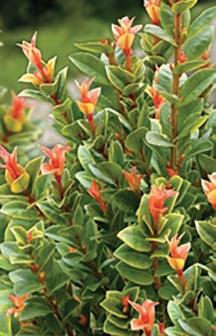
About the garden magazine | page 07
FULL SUN PART SHADE
SIZE 2.5mH 1mW SIZE 2-3m Height
LOVES POTS
COASTAL
CLIMBER
region.















Floral emblems are a term used to describe a specific flower which is associated with a region. It is a term that is used mainly in Australia and Canada, whereas in America they use the term of “state flower”. The floral emblem for the nation of Australia is the golden wattle, specifically Acacia pycnantha. Each state or territory then has its own floral emblem.
This can be broken down further for some cities. Sydney floral emblem is a banksia flower, specifically from Banksia ericifolia. The floral emblem for Brisbane, though not a native plant but one which grows well in the area is the red poinsettia or Euphorbia pulcherrima




The city of Cairns went for the Golden Penda or Xanthostemon chrysanthus which is an Australian native plant and has brilliant displays of yellow flowers. Darwin’s floral emblem of the Red Kurrajong or Brachychiton megaphyllus was adopted in 1966 and is native to the region.

Some councils have implemented floral emblems. Ipswich City Council has Eucalyptus curtisii, or the Plunkett Mallee. Bundaberg Regional Council has the Golden penda as their floral emblem and the Uralla Shire Council has adopted Cheiranthera telfordii which was first collected by Ian Telford from the University of New England and carries his name. The “ii”or “i” at the end of his name indicates a male found and named the plant. If the species name ends with “ae” then it is attributed to a woman.
Finding floral emblems sometimes uncovers interesting stories that go with them. For example, the emblem for Darwin, the Red Kurrajong, was lost for years before being rediscovered in old records. Not all regions or cities have floral emblems but it’s something worth investigating and then exploring the reason it was adopted. It is surprising how many were voted in by informal public votes, often through newspapers and others by government bodies. If your area or city has a floral emblem, what is it and how did it come about? Email us your local floral emblem - atg@aboutthegarden.com.au
page 08 | About the garden magazine
Banksia ericifolia Sydney floral emblem Waratah NSW floral emblem Red poinsettia Brisbane floral emblem

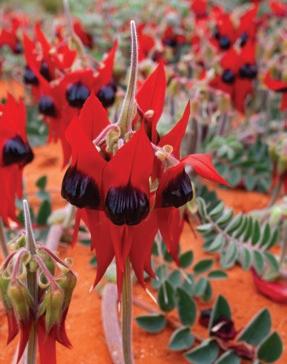
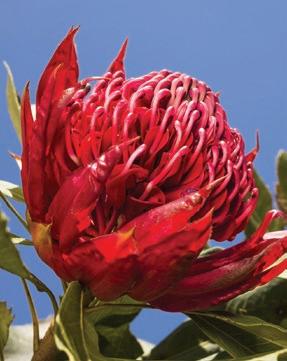
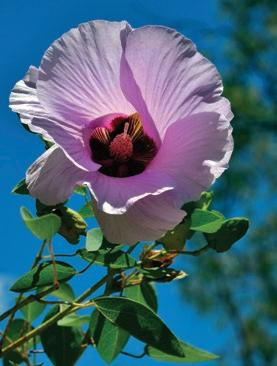





Western Australia - Red and Green Kangaroo Paw Anigozanthos manglesii South Australia - Sturt’s Desert Pea Swainsona formosa New South Wales - Waratah Telopea speciosissima Northern Territory - Sturt’s Desert Rose Gossypium sturtianum Australia National Emblem - Golden Wattle Acacia pycnantha Australian Capital Territory - Royal Bluebell Wahlenbergia gloriosa Queensland - Cooktown Orchid Dendrobium phalaenopsis Victoria - Common Heath Epacris impressa Tasmania - Tasmanian Blue Gum Eucalyptus globulus
Surprisingly there are many natives which can grow happily in a restricted area. The key factors to successfully growing Australian plants in containers are exactly the same as for exotic plants - drainage and nutrition.

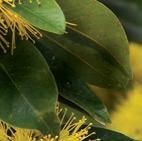
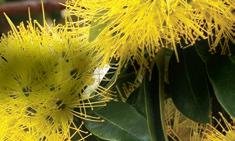
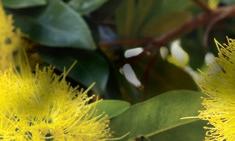

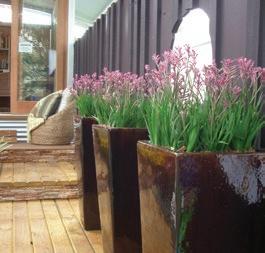
The main points to remember are that good drainage is even more important for certain natives (mainly those originating in arid areas with very light, sandy soils) and that plants in the Proteaceae family require low phosphorus fertilisers.

When growing plants in containers it is important to know their type and origin so ask yourself the following questions:
• Tree, shrub or climber/groundcover?
• Does it originate in a high or low rainfall area?
• Is its natural habitat sun or shade?
• Natural soil type - light (sandy) or heavy (clay)?
The type of plant determines the ultimate pot size. Knowing its origins will tell you the type of growing media you need, how much water and whether it should be placed in sun or shade. If the label doesn’t
Kangaroo Paws
Callistemon ‘Little John’
Banksia ‘Birthday Candles’
page 10 | About the garden magazine
give you enough information, ask nursery staff.
Any type of container can be used, providing it has plenty of adequate sized drainage holes. Too small and they will drain too slowly and block up easily; too large and all your precious water will run away too fast. Most good quality terracotta and plastic pots come with good drainage holes; a medium-sized pot should have no less than four, about the size of a five cent piece.
A good-quality, low-phosphorus potting mix, Searles Native Plant Mix, containing controlled-release fertiliser, is suitable for most Australian native plants.
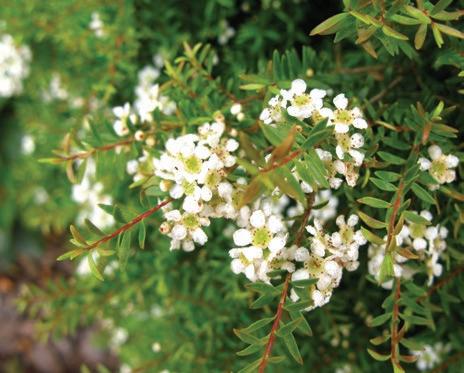


WATERING
Develop a watering regime which keeps the soil just moist but not too wet. Use your finger to test this. Frequency of watering is governed by:
• Time of year. Generally less watering is required in winter. Queensland and northern NSW native plants, unlike exotics, are geared to a wet summer and dry winter. However, because these plants are still active in the cool season and, when potted, can’t draw any residual water from the soil, they will need some water to stop them drying out completely through winter.
• Sun or shade.
• Indoors or outdoors.
• Basket or pot - baskets require more frequent watering.
• Rate of growth - a fast-growing plant will take up more water.









• Use of water-saving granules.
The best time to water is in the evening or at night from late winter to early autumn, and in the tropics it’s best to water in the evening all year round.
FERTILISING
Use a plant food such as Searles Native Plant Food at the recommended rate for the pot size and apply every 8-12 weeks from early spring through to autumn or a controlled release fertiliser, Robust Native Plants every 6 months.


About the garden magazine | page 11
Baeckea
Prostanthera
Grevillea ‘Woolly Bear Hero’ - ground cover ideal for hanging baskets
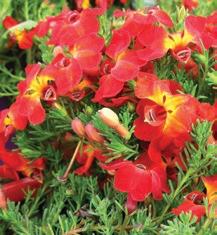





 Hoya
Asplenium
Tassel Fern
Hoya
Asplenium
Tassel Fern
page 12 | About the garden magazine
Scaevola in hanging basketPandorea jasminoides
Lechenaultia
Dampiera
MULCH

Large pots of rainforest plants can be topped with organic mulch to conserve moisture. Dryland species which usually grow in bare ground can be mulched with gravel or pebbles.
INDOOR AND OUTDOOR
Generally, rainforest and understorey plants can be grown indoors or on verandas and patios while those which require long hours of sun should be kept out of doors. However, even the most shadeloving plants need to be spelled out of doors occasionally, say at least one month twice a year, and sunlovers can be kept indoors for short periods (perhaps for a few days when flowering) or where there is direct sun for much of the day, for example a northfacing window. Air conditioning and artificial heating both cause plants to dry out; so ferns and rainforest species in particular will need to be ‘misted’ with a light spray of water to maintain healthy foliage.
Protect herbs, vegetables, trees and shrubs from possums, kangaroos, wallabies, rabbits, hares, bandicoots, deer, foxes and other wildlife.


Protect vegetables, fruit trees, ornamentals, seedlings and buildings from cockatoos, crows, ducks, pigeons, rosellas, starlings, swallows, other birds, fruit bats and microbats.
Protects homes, gardens, patios, shop fronts and paved areas from both dogs and cats or rats and mice.
Protects one plant or a whole area — perimeter &/or band sprays.

Repels — without harming animals or humans. Not considered a poison — no withholding period. Easy to use — spray on. Effective when dry.
Safe, Proven and Effective.
Available in 100g, 1Kg & 4Kg Sizes.
is unique. Reject products said to be "just as good", nothing is at all "like it".
For more specific information send 2 x $1 stamps, Please mention your problem, post to: D-TER, Dept. A, PO Box 3, Oyster Bay, NSW 2225.
Enquiries: Phone: (02) 9589 0703 Fax: (02) 9589 0147
About the garden magazine | page 13
GG20-260/02
MenthaLemon scented myrtle
Blueberry Ash
When to plant


















Cucumbers are a warm season crop and should be sown or transplanted in spring once the soil has warmed up, and through summer. For dry tropics and tropical coast regions they can also be planted in early winter. Cucumber can be planted from seed or seedlings, with many varieties to choose from. Cultivate groups of three plants each month successively over the warm season.
Where to plant






Cucumbers like to be grown in loose soil that has been generously manured the season before. They can be grown in either sun or semi-shade, preferably supported by a trellis or fence to keep the ripening fruits off the ground.





How to plant







Whether your soil is light sand or heavy clay, dig it over to a depth of 15cm, adding Searles Premium Compost Mix to improve its structure and increase its water-holding capacity. Alternatively, plant straight into Searles Herb & Vegetable Specialty Mix for gardens and pots. Cucumbers prefer a neutral soil, so adjust your pH if it is more or less than 6.5. Cucumbers are shallowrooted so ensure that the soil















page 14 | About the garden magazine
Cucumber is one of the easiest crops to grow and their health benefits and body temperature cooling properties make them an ideal addition to any summer salad.
is free of clumps to enable the delicate root system of the plants to penetrate it easily. Seed should be sown in groups of three, spaced according to the directions on the packet, into a saucer-like depression in the soil. Seedlings should be planted in a similar fashion, taking care not to damage the delicate roots when transplanting. Water immediately and maintain the soil at a consistently high moisture level until fruits begin to form.
How to maintain



Water should be plentiful up until the time that the fruits begin to mature, after which it should be moderated to keep the roots just moist. To protect the shallow roots from drying out, spread a layer of sugar cane under each plant, topping it up as the plant grows outward. This conserves soil moisture and prevents the fruits and foliage from coming into contact with the soil. If space is limited, train the vines up a trellis or fence. Cucumbers are pollinated by bees, so it is essential not to use insecticides around them. If bees are scarce in your garden, hand pollination is simple and effective. The male flower can be identified by its powdery, pollen-covered stamens in the centre. Gently remove this flower and lightly wipe the inside of the female flower (identified by a slight swelling at its base) with it. Once there are five or six pollinated flowers on the stem, trim the trailing end back to force better development of the remaining fruits.
Harvesting
Cucumbers should be picked when they are young and at a size appropriate to their variety. For instance, Lebanese cucumbers are edible when they are 10cm long, but the telegraph varieties need to grow to approximately 30cm before picking. The more you pick, the more fruits are produced.


Pests and diseases













Mildew is the main problem with cucumbers, and can be discouraged with a fortnightly application of a soluble fish and seaweed fertiliser, applied in the morning. SeaMax Organic Liquid Fertiliser is ideal for healthy growing habits. If you live in a very humid area, select one of the mildew resistant varieties now available. If mildew becomes a problem it can be controlled by spraying with Searles Mancozeb Plus.



Companions
Plant with beans, broccoli, carrots, lettuce, peas, radish, sweet corn.


Six outstanding chillies to spice up the garden.









The season starts with ‘Early Jalapeno’ which fruits just 10 weeks from transplant and continues with other Diggers favourites including our most popular chilli of all, ‘Joe’s Long Cayenne’ which is suited to fresh salads, cooking or drying.

If you plant for both performance and produce, check out the highly ornamental ‘Maui Purple’ which has vibrant purple foliage as well as delicious purple fruit which gets hotter as it ripens from purple to red. Of course, if you prefer a more mild golden chilli, look for the Mexican heirloom ‘Sante fe Grande’ named for its golden colour and sweet mild fruit, but if you prefer some heat, look for the incredibly spicy ‘Habanero Mustard’ - it packs a punch!

All are suitable for pots or garden beds, but if you only have room for a small pot, look for ‘Red Hot Cherry’ which looks great when decorated in fruit in summer. To enjoy the flavour of home grown heirloom vegetables at home, look for Diggers Heirloom Selections.






*Early Jalapeno can be picked green or allowed to ripen to red, if preferred.









About the garden magazine | page 15
*
A grain-based middleeastern version of tabbouleh celebrating bulgur wheat.
simple recipes made from garden kitchen produce



Ingredients Prepare
3 tablespoons Bulgur, dry
1 1/2 cups tomatoes, diced
1 cup, cucumber, diced
1/3 cup spring onions or shallots, minced
2 cups flat leaf parsley, finely chopped
1 tablespoon mint leaves, finely chopped
½ teaspoon Allspice powder
2 tablespoons fresh lemon juice

Salt & pepper to taste
¼ cup extra virgin olive oil (about 60 ml)
Prepare the Bulgur as per packet instructions and add a teaspoon of olive oil to separate, place in mixing bowl.
Add the sliced tomatoes, cucumber, shallots, parsley and mint to the bowl. Next, add the allspice powder, stir. Mix though half of the lemon juice, salt and pepper. Add more lemon juice to taste. Drizzle olive oil, stir through. Serve in serving bowl immediately or refrigerate for later.
page 16 | About the garden magazine
Classic and simple seafood pasta dish.
350g fettuccine pasta
6 cloves of garlic, minced
Half onion, finely chopped
200g bacon, diced
1 tablespoon of sesame oil
1 tablespoon of fish sauce
500g raw prawns, shelled, deveined, tail on
Prepare
Half punnet of cherry tomatoes
Handful of capers and olives (optional)
Parsley, handful, finely chopped
Salt and pepper (optional) Parmesan cheese
Add pasta to boiling water and cook al dente, then drain.
In a low heat pan, heat olive oil and cook garlic and onion until glossy. Turn up heat to high and cook bacon. Add in sesame oil and fish sauce and stir. Add in raw prawns and cherry tomatoes. Once prawns are cooked, stir through capers and olives.
Toss cooked pasta into the pan with prawns to combine. Garnish with parsley, salt and pepper.
Serve
Serve with grated parmesan cheese.
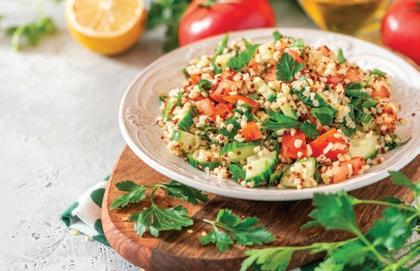
Serves 4-5
pineapple, chunks
reduced-fat coconut milk
lime juice
sparkling water
Prepare
Blend pineapple, coconut milk and lime juice in a blender on high speed until smooth. Divide between 2 glasses. Top with sparkling water and serve.
Prepare
pineapple chunks
Coconut cream

Pineapple juice
Place all ingredients in a blender and blend until smooth. Pour into a glass, garnish with a pineapple wedge and serve chilled.

www.aboutthegarden.com.au Ingredients 1 cup
1 cup
2 tablespoon
2 cups
Ingredients 1 cup
1/3 cup
1/2 cup
for more recipes, visit About the garden magazine | page 17
summer planting and care guide
> Water tomatoes consistently. Dramatic changes in watering and temperatures will encourage fungal problems, blossom-end rot and poor fruiting.
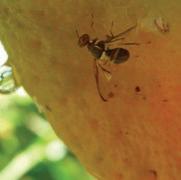

> Plant corn early summer in rows close together. Water regularly to keep their growth fast.



> Harvest macadamias as they drop to the ground. Store in dry, cool place.
> Ginger and turmeric should already be planted and growing rampantly by now, but rhizomes can still be planted early summer in pots for temperate and cooler areas. They like warm weather, humidity and rich, moist soil. Keep the water up during summer and check for good drainage. In the tropics, it usually needs a part shade position, but in cooler areas, full sun is usually best.
> Iceberg and cos lettuce will always be popular lettuces but consider growing some of the more unusual and decorative varieties such as ‘Red Oakleaf’, ‘Lollo Rossa’ and ‘Red Salad Bowl’. Mix them with frilled endive, green chicory and the deliciously peppery rocket for a taste sensation. Water daily for better tasting leaves.
> Cucurbits include squash, cucumbers, pumpkins and zucchini are renowned for producing massive yields. Sun, moisture and rich composts are their growing











requirements and if these are met a couple of plants of each will produce more than enough for the average household. For a wet season, look out for powdery mildew and treat early with Searles Mancozeb Plus Repeat spray if necessary.

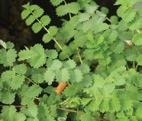

> Capsicums, chillies, eggplant and tomatoes are star performers in the summer vegetable garden and combine into wonderfully spicy and aromatic dishes in the kitchen. For pot life, plant in Searles Herb & Vegetable Specialty Mix or Searles Planting Mix for garden beds.

> Cooling herbs can bring an extra dimension to summer salads and drinks. Try salad burnett (for a flavour as cool as a cucumber), mint or Vietnamese mint for a peppery, coriander-like zing! Give summer herbs a boost with SeaMax Organic Fertiliser — a health tonic and plant food all in one.
> Basil, coriander, chives and lemon scented herbs love warm sunny areas in the summer garden. Ensure watering is regular and water more during hot, dry days.
> Citrus and fruit trees still grow during summer, so they need consistent watering and a dose of organic fertiliser, 5 IN 1 Fruit & Flower Fertiliser at the start of the season to aid growth and combat the hot weather.
page 18
salad burnett
Vietnamese mint
> Fertilise frangipani with Searles Hibiscus & Bougainvillea Food for better flowering. Frangipani rust is new to home gardens, so remove any fallen leaves around the base of the plant and bin them to help prevent spores spreading. Control any rust outbreak by spraying Searles Trifend on the plant, leaves and on the ground where the leaves have fallen.
> Most plants with grey foliage are heat-tolerant and are useful for providing a contrast to their green neighbours. Shrubs such as rosemary, rue, salvia, helichrysum, lavender and artemisia are both aromatic and hardy. Gazanias and arctotis form prostrate mats of silver leaves and vivid daisy flowers.


> If you haven’t already planted summer annuals, plant these now, petunias, sunflowers, rudbeckia, phlox, californian poppy, amaranthus, aster, balsam, bedding begonia, carnation, portulaca, salvia, celosia, dahlia, dianthus, gerbera, gypsophila, zinnia and verbena.





Hoyas will quickly become a gardeners favourite after they experience their hardiness and scented pendulous blooms during the warmer months from spring to autumn. Their small root requirements make them perfect for pots. If planting them in the ground, provide them with a trellis or climbing vessel to happily trail along. Ideally, plant hoyas in Cymbidium & Bromeliad Specialty Mix. This mix has open free draining properties and contains a 9 month fertiliser for flower boosting.
Hoyas flourish in very bright light, in dappled shade areas and under patios in warmer zones. Keep soil moist. Feeding hoyas before their flowering season and during flowering will greatly encourage more blooms. Feed at half rate with Searles Flourish Orchid Booster Soluble Plant Food borders.

> Liquid feed summer flowering allamandas, mandevillas, bleeding heart vine and Rangoon creeper with Searles Flourish Flowers & Foliage Soluble Plant Food to keep them flowering.

> For a big summer flowering tree to feature in your garden, plant red flowering poinciana, crepe myrtles and the mauvepink pompom tree.
> Lillypillies are flowering now. Plant them for screens, hedges and borders. Choose psyllid resistant varieties.
myrtle


Crucifix orchid, Epidendrum sp. is one of the easiest orchids to grow in the garden or fork of a tree.

Geraniums are a water wise summer stunner that look great in any garden style.
> Some native grevilleas and callistemons are flowering in summer. Other flowering natives include, such as water gum (Tristaniopsis laurina), red flowering gum (Corymbia ficifolia) and NSW Christmas bush (Ceratopetalum gummiferum). Try growing Lemon myrtle, a bush tucker, displaying lemon scented summer flowers.




> Feed hydrangeas fortnightly with Searles Flourish Azalea, Camellia & Gardenia during their peak flowering period.


For festival red foliage and flowers for Christmas celebrations, try NSW Christmas bush, poinsettias, red geraniums, verbenas, red mandevillas, anthuriums, and throw in some leafy green herbs to complement the reds.

About the garden magazine | page 19
>
More growing info, scan here
When you buy a living Christmas tree, the longest you should keep it inside is about ten days or less. If you want to get one earlier, keep it outside near the front door for a few days to be festive, this will help raise its survival rate for later.

After Christmas, place it outside in a shady position for a week, then move it into the morning sun and sheltered from the afternoon heat for a week. After that, it should be fine to go outside permanently. Water the tree well, without a saucer present, as pooling water at the bottom of the pot can lead to root rot. The water should freely drain out. If possible, take the tree outside in a shady spot, to water in the morning before going out, and move it back in when you get home.
When taking it back outdoor give it a drink once a week with SeaMax Seaweed to help it restart. Keep this up over the coming month to reinvigorate the tree. If you plant it into the garden, add 90ml or two caps of Liquid Seaweed to 9L of water in a watering can and water the tree once planted to settle the tree into the new home. Repeat liquid feeding fortnightly for six weeks.


> Crepe myrtles and poincianas are on display now. Both trees make stunning summer garden features and provide shade.
> Feed frangipanis with Searles Hibiscus & Bougainvillea Food to keep the scented flower coming.
If you haven’t already mulched the garden soil for sun and heat protection, do so now. Before mulching, give plants a liquid dose of SeaMax Organic Fertiliser to promote strong plant health to combat the heat.
Plant warm season cucurbits such as pumpkin, watermelon, cucumber, summer squash and other vegetables artichoke, beans, capsicum, celery, Chinese cabbage, eggplant, kohlrabi, leek, lettuce, okra, onion, potato (tubers), radish, rhubarb (crowns), rosella, silver beet, spring onion, squash, sweet corn, sweet potato and tomato. For herb gardens, plant basil, chives, coriander, fennel, gotu kola, heliotrope, lemongrass, mint, parsley and tarragon.





Spread zinnias, portulacas, summer flowering salvias, torenias and marigolds around the sunny spots in the garden.
Plant coleus for strong colour in shady areas.

For more information for what to grow in your climatic zone visit www.aboutthegarden.com.au



Rockhampton Hervey Bay BrisbaneToowoomba Warwick Grafton Port Macquarie
page 20 | About the garden magazine
For those tricky dry shady spots where you want flowers you can’t beat the Clivea. These evergreen bulbous clumping perennials have showy glossy dark green strappy leaves and bunches of flowers which appear spring and summer. They come in a vast array of apricots, oranges and almost red as well as cream and yellow. The flower forms vary as well.
> The Rangoon Creeper, Quisqualis indica, is a climber from the tropics that has a true zest for life. Showing strongest growth during spring and summer, the flowers are produced along the arching branches in gentle clusters. Flowers initially open white, fade to cherry pink and then to a rich watermelon red. The perfume of this climber is rich and fruity with a hint of spice for good measure. This a fast growing species that will require regular tip pruning to keep into shape, yet avoid heavy pruning during active growth as this will not allow for the beautiful flowers to be formed. It is best planted over pergolas and archways where you have no choice but to pass beneath it to experience its delicious perfume to the fullest.

> Summer is the time to plant heliconias. Heliconias grow fast, especially in the summer, so they can be used to create a screen between properties. They require little maintenance.

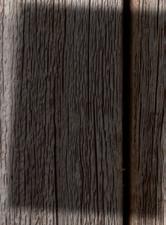


> Time to plant capsicums, cucumbers, eggplant, lettuces, melons, mustard, pumpkins, radish, spring onions, squash, sweet corn, potatoes, tomatoes and zucchinis. Harvest veggies while still young and tender. In the tropics the heat and humidity can ripen vegetables quickly. Liquid feed fortnightly with 5 IN 1 Organic Fertiliser Liquid to keep growth strong and promote flowering.
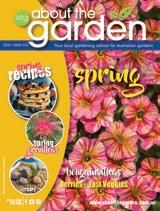

Payment Methods




Pay by direct debt.
will send you account details via email. Cheques will not be accepted.

or follow us on Name: ............................................................................... Age: 25–35 36–45 46–55 55+ Address: ........................................................................... .................................... City: ............................................ State: .............. P/code: ................... Phone: .............................................................................. Email: ............................................................................... 1 year ($19.00) 2 years ($31.00)
Charge this to my: Visa Mastercard Card no: Card holder’s name:.......................................................... Expiry date: ................Signature: ..................................... Summer 2022 delivered toyour door Subscribe to About the garden magazine Please send this form to: About the Garden P.O. Box 70 Kilcoy Q. 4515 atg@aboutthegarden.com.au Ph:(07) 5422 3090 FOLLOW US ON Darwin Cairns Rockhampton Brisbane EmeraldLongreach Mt. Isa >
OR
We
www.aboutthegarden.com.au Quisqualis or subscribe online www.aboutthegarden.com.au/purchase or scan QR code
> Summer is generally a time where plant growth is rapid. Liquid feed with SeaMax Organic Fertiliser Liquid to fertilise and provide strong and sustainable nutrients for plant growth and defence.



> Plant beans, beetroot, cabbage, capsicum, carrot, cauliflower, cucumber, English spinach, kohlrabi, leek, lettuce, onion, parsnip, pumpkin, radish, silver beet, spring squash, swede, sweet corn, tomato, turnip, watermelon and zucchini. Plant basil, chives, coriander, lemongrass, marjoram, mint, oregano, parsley, rosemary, tarragon and thyme. Borage is an easy no fuss annual herb with dainty blue star shaped flowers appearing in summer. Grow borage for herbal tea, salads and its myriad of medicinal qualities.
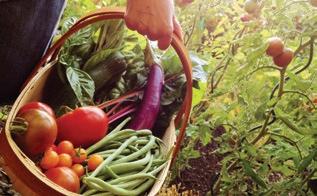
> Plant ageratum, alyssum, cineraria, cleome, cyclamen, forget-me-not, fuchsias, geraniums, Iceland poppy, lobelia, lupin, marigold, pansy, petunia, phlox, primula, stock, verbena, wallflower and zinnia.

> Frangipani, corymbias, metrosideros, gardenias, crepe myrtles, hydrangeas and mandevillas are all flowering beauties on show during summer.
> Watch out for fruit fly activity on tomatoes, citrus and capsicum. Monitor with Searles Fruit Fly traps
Hydrangeas bloom easily during summer. Find stunning modern varieties in gardening outlets to plant. Plant in Azalea & Camellia Specialty Mix.
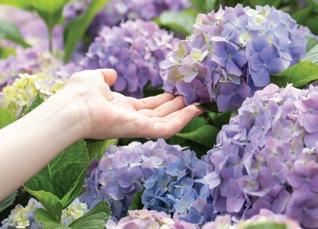
> Summer fruiting raspberry bushes are ablaze of fruits this time of year. Use a bird friendly net on ripening summer fruit such as blueberries, cherries and currents.
> Agapanthus, ageratum, alyssum, aster, boronia, calceolaria, cleome, cosmos, California poppy, cyclamen, dahlia, gazanias, geraniums, Iceland poppy, linaria, marigold, nasturtium, pansy, phlox, salvia, stock, sunflower, verbena, vinca, viola, wallflower and zinnias give summer gardens colour.




> Time to plant beans, beetroot, broccoli, brussel sprouts, cabbages, capsicums, celery, cucumbers, cress, eggplant, leeks, lettuces, melons, mustard, pak choy, pumpkins, radish, rhubarb, rocket, silver beets, spring onions, squash, sweet corn, sweet potato, tomatoes and zucchinis. Plant basil, chives, coriander, fennel, gotu kola, heliotrope, lovage, mint, parsley and tarragon.

> Aphids commonly appear on flushes of new growth. Generally, if there are predatory insects in the area such as ladybird larvae, the aphids will be kept under control. In severe cases, treat aphids with Searles Bug Beater, a natural pyrethrum spray or an organic spray Searles Ecofend Vegetable & Garden Insect & Mite spray.
Tomatoes and beans can be grown through the summer months. Keep growth fast and healthy with fortnightly feeds of SeaMax Organic Fertiliser Liquid.
For more information for what to grow in your climatic zone visit
Hobart Rockhampton Hervey Bay Brisbane Warwick Grafton Port Macquarie Sydney Canberra Melbourne Wodonga Adelaide Geraldton Perth Albany Port Augusta Esperance Moree Armidale Orange
Emerald Rockhampton Gladstone Hervey Bay BrisbaneToowoomba Warwick Port Macquarie Sydney Melbourne Wodonga Adelaide Albany Esperance Armidale Tamworth TM page 22 | About the garden magazine
> Bracteantha daisies love sun and keeps summer gardens smiling with bright colour.
> Mandevilla flowers are still on show from summer until autumn, their dancing big blooms are always something to stop and admire. Salvias are also flowering until autumn providing fodder for the bees. Water and fertilise hydrangeas regularly during summer for better flowering. Use a fertiliser for acid loving plants like Searles Azalea & Camellia Soluble Plant Food. Water regularly to avoid wilting leaves.
> Crepe myrtles come out in full display during summer. The tree is generously loaded with crepelike long lasting flowers. Ask at your local garden centre about the array of available colours and also dwarf forms.
> Figs love the ideal conditions of hot, dry summers the Mediterranean climate brings. Figs are simple to grow if planted in a full sun position with soil improved with rich composted manures. Harvest time is from late February into autumn. Prune to your desired height to encourage better fruiting next season.
> Plant tomato, zucchini, sweet corn and capsicum. Keep well watered. A second crop can be planted a month later for extended harvest. Keep watering tomatoes constantly during the summer months. Irregular watering will encourage blossom end rot caused by calcium deficiency.
Salvias, crepe myrtles, mandevillas, petunias, hydrangeas, bougainvilleas, geraniums, dahlias, portulacas, verbena and zinnias love the summer.
> Succulents like yuccas, mesembryanthemum, sedums, agaves and aloes are dead set winners for arid conditions but need to be accommodated where there is plenty of space and won’t look incongruous with their surroundings.
> Plant petunias, scaevolas, calibrachoas or portulacas for hanging basket or pot displays in a premium potting mix with advanced water technology. Searles Platinum Potting Mix contains 18 month fertiliser and is excellent on water conservation.
> Tomatoes, capsicums, eggplant, cucumbers and zucchini are perfect to grow now. Liquid feed with SeaMax Organic Fertiliser Liquid fortnightly to promote fruiting. Watch out for powdery mildew on the leaves and spray with Mancozeb Plus to control the damage.
> The hotter the temperature, the more water is required for your garden. Fruit trees and vegetables require regular watering to keep growing.





> Salvias are ideally suited to hot, dry conditions, flowering happily during summer and autumn and providing fodder for the bees.

> Mandevilla and salvia flowers are still on show during summer. Sprinkle Recharge Ultimate Fertiliser around the soil to feed plants for many months and ensure water is getting to the roots.
Hibiscus make an impressive display signalling summer is here. Promote more flowering with Searles Hibiscus and Bougainvillea Food.

or follow us on
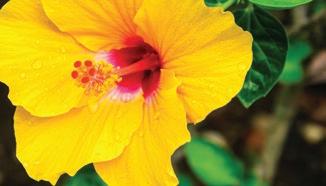
Perth Hobart Emerald Rockhampton Gladstone Hervey Bay BrisbaneToowoomba Grafton Port Macquarie Newcastle Sydney Wodonga Adelaide Albany Port Augusta Tamworth Orange Brisbane Kalgoorlie Carnarvon Alice Springs Perth Hobart Emerald Rockhampton Gladstone Hervey Bay Toowoomba Grafton Port Macquarie Newcastle Sydney Wodonga Adelaide Albany Port Augusta Tamworth Orange
www.aboutthegarden.com.au
About the garden magazine | page 23
Ideal for better plants in gardens
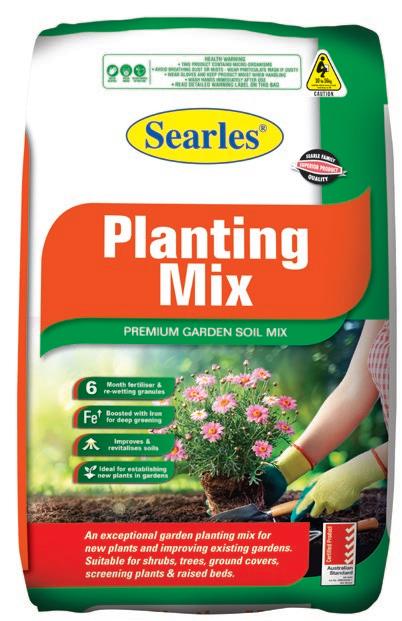
Faster & stronger new plant establishment.

More robust plant growth.
Improves soils & adds nutrients.
plants for
months.

•
•
•
Ask for Searles quality garden products at your nearest gardening outlet. www.searlesgardening.com.au • Feeds
6





























































































































 Hoya
Asplenium
Tassel Fern
Hoya
Asplenium
Tassel Fern




















































































































